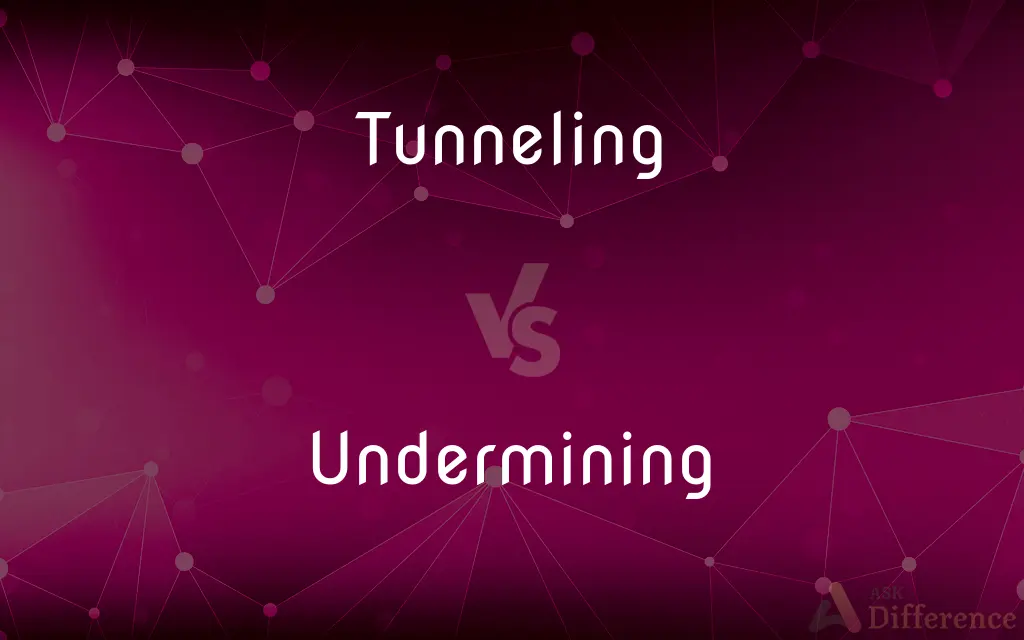Tunneling vs. Undermining — What's the Difference?
By Maham Liaqat & Fiza Rafique — Published on March 4, 2024
Tunneling refers to creating a narrow passageway through something, often used in medical or engineering contexts, while undermining involves eroding the base or foundation, metaphorically or physically, weakening stability or support.

Difference Between Tunneling and Undermining
Table of Contents
ADVERTISEMENT
Key Differences
Tunneling and undermining, though sometimes used interchangeably in casual discourse, hold distinct meanings in professional and technical contexts.
Tunneling specifically denotes the process of making a hole or tunnel through an area or material. In medicine, this could refer to the creation of a passageway under the skin or in tissue, often caused by infection or disease. In engineering, it describes the act of constructing a tunnel, such as those used for roads, trains, or utilities, through mountains, under cities, or beneath water bodies.
Undermining, on the other hand, refers to the process of removing material from an area's base or foundation, causing a potential collapse or failure of the structure above. In a medical context, undermining is seen when the edge of a wound extends horizontally under the skin, creating a large cavity under the wound bed, which can complicate healing. In social or organizational contexts, undermining typically involves actions or behaviors that weaken someone's authority, confidence, or effectiveness, often done surreptitiously.
The key distinction lies in their purposes and outcomes. Tunneling is often a deliberate, constructive process aimed at creating a passage or conduit, while undermining tends to have negative connotations, implying destruction, erosion, or sabotage of a foundation or authority. Tunneling can be seen as a form of progress or development, creating new pathways and connections, whereas undermining often signifies deterioration or weakening of an existing structure or relationship.
Both processes, while different in their objectives and implications, involve the removal or displacement of material. In practical applications, the choice between tunneling and undermining depends on the desired outcome: constructing a pathway or compromising a structure's integrity. Recognizing the difference is crucial in fields like medicine, construction, and interpersonal or organizational dynamics, ensuring accurate communication and appropriate strategies.
ADVERTISEMENT
Comparison Chart
Definition
Creating a passageway through a material or area
Eroding the base or foundation of something
Purpose
To construct a pathway or conduit
To weaken or cause potential collapse
Contexts
Medicine, engineering, construction
Medicine, social/organizational, construction
Connotations
Constructive, progress-oriented
Destructive, weakening
Outcomes
Passage creation, connectivity enhancement
Stability erosion, authority or support weakening
Compare with Definitions
Tunneling
The act of making a hole or passage through or under an obstacle.
Tunneling through the mountain reduced the travel time between the cities.
Undermining
The process of making an area under a structure hollow, risking collapse.
Water flow was undermining the foundation of the bridge.
Tunneling
In medicine, a path created by disease or infection under the skin.
The doctor noted tunneling in the tissue, indicating a severe infection.
Undermining
In wound care, a larger cavity forming under the skin around a wound.
The nurse treated the wound carefully to address the undermining.
Tunneling
A method in computer networks to encapsulate data for secure transmission.
VPNs use tunneling to protect the privacy of online communications.
Undermining
Actions that subtly weaken someone's authority or confidence.
His constant criticism was undermining her confidence in her work.
Tunneling
In gardening, the activity of pests creating underground passages.
Moles were tunneling through the garden, disrupting the root systems.
Undermining
In politics, the act of subtly weakening or sabotaging opposition.
The campaign strategy involved undermining the opponent's credibility.
Tunneling
Used in espionage or military contexts to secretly place explosives or escape.
Prisoners attempted escape by tunneling beneath the fence.
Undermining
Erosion of support or the base of natural formations.
The riverbank was undermining, threatening nearby homes with collapse.
Tunneling
In quantum mechanics, the passing of a particle through a seemingly impenetrable barrier without a cause that is explainable by classical physics.
Undermining
To weaken by wearing away a base or foundation
Water has undermined the stone foundations.
Tunneling
(physics) The quantum mechanical passing of a particle through an energy barrier.
Undermining
To weaken, injure, or impair, often by degrees or imperceptibly; sap
Late hours can undermine one's health.
Tunneling
A feature of the file system that allows files to preserve certain properties, such as creation date, even after being deleted and recreated.
Undermining
To dig a mine or tunnel beneath.
Undermining
Present participle of undermine
Undermining
The act or process by which something is undermined.
Common Curiosities
What causes tunneling in wounds?
Tunneling in wounds can be caused by infection, disease progression, or improper wound healing, leading to cavities under the skin.
Can tunneling be beneficial?
Yes, in contexts like construction or medicine, tunneling can create essential pathways, like transportation tunnels or surgical access points.
What are the signs of undermining in a relationship?
Signs include lack of trust, reduced confidence, and a feeling of instability or being sabotaged by the actions of another.
Can undermining have positive outcomes?
In rare contexts, such as strategic business moves or political strategies, undermining might be seen as positive by those employing the tactic, but it generally has negative implications for relationships and structures.
Is tunneling always intentional?
While tunneling is often intentional in engineering or medical contexts, it can be unintentional in cases like pest activity or natural processes.
What is the difference between tunneling and undermining in wound care?
Tunneling refers to a narrow passageway that extends from a wound into surrounding tissue, while undermining occurs when the skin around the perimeter of the wound becomes eroded, leading to a cavity under the skin edge.
How do animals contribute to tunneling and undermining?
Animals like moles, gophers, and termites can create tunnels and undermine structures unintentionally by removing soil or material from beneath surfaces, potentially causing damage.
How do I know if my property is at risk of undermining?
Signs include new or expanding cracks in foundations or walls, sinking floors, or the appearance of sinkholes on the property, indicating potential undermining issues.
How can undermining be prevented in construction?
Preventing undermining involves ensuring proper drainage, stable foundations, and materials resistant to erosion or wear.
Can tunneling be used to repair undermining damage?
In some cases, tunneling techniques, such as microtunneling or pipe jacking, can be used to underpin or stabilize structures affected by undermining, effectively repairing or mitigating damage.
How is undermining detected in medical settings?
It's detected through physical examination, feeling for cavities or spaces under the skin around a wound, indicating a larger affected area.
What are the environmental impacts of tunneling and undermining?
Tunneling can disrupt ecosystems and water tables, while undermining can lead to habitat destruction and increased erosion. Both processes require careful planning to minimize environmental damage.
What role does water play in undermining?
Water significantly contributes to undermining through erosion, washing away soil or material from under foundations or natural structures, leading to potential collapses.
How does soil type affect tunneling and undermining in construction?
Soil type plays a crucial role; sandy or loose soils are more prone to undermining due to water flow, while clayey soils can offer more resistance. Tunneling in softer soils may require additional support to prevent collapses.
Can undermining affect my home's value?
Yes, signs of undermining can significantly decrease a property's value due to the potential for major structural damage, making it a critical issue to address for homeowners.
Share Your Discovery

Previous Comparison
Nano SIM vs. Micro SIM
Next Comparison
Golden Flax Seeds vs. Brown Flax SeedsAuthor Spotlight
Written by
Maham LiaqatCo-written by
Fiza RafiqueFiza Rafique is a skilled content writer at AskDifference.com, where she meticulously refines and enhances written pieces. Drawing from her vast editorial expertise, Fiza ensures clarity, accuracy, and precision in every article. Passionate about language, she continually seeks to elevate the quality of content for readers worldwide.













































